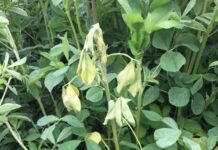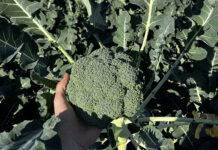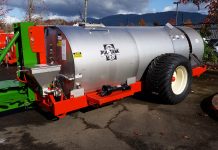
Tank mixing, the process of combining multiple crop protection chemicals, adjuvants or fertility products into the same tank, is a well-known practice. We all understand the benefits of reduced passes across the field, increasing efficiency of your applications and saving precious time. However, it’s time to shift our mindsets and tanks into applying old techniques to new concepts. The concept I am referring to is soil health. You may be thinking, ‘This is not a new concept’; however, utilizing products or a blend of multiple products that provide soil health-like properties for specific soil and crop responses is a newly emerging idea (Figure 1).
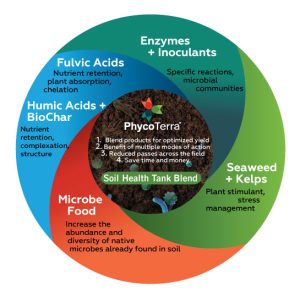
For this article, I will refer to products currently classified as biostimulants, biologicals and carbon-based products as “soil health” products. Products tailored for impacting specific soil health properties are more readily available than ever, and, frankly, this flooding of the marketplace creates much confusion among end users on performance expectations. From my own experience, I have encountered frustrated growers with numerous concerns such as, ‘These products don’t work for me’, ‘There is too much variability,’ or ‘I am unsure of what products I need.’ These are valid concerns; however, there may be some very simple solutions to addressing these problems (how we mix them in the tank or apply them to the field). When incorporating these soil health products, addressing a few basic points before getting started can help ensure the results we hope to achieve in the field. These include:
How can I understand the mode of action or the primary function of the product?
What is the soil health problem or challenge/s in your field?
Which soil health or blend of soil health products are available for my desired results?
How do I ensure my soil health blend is properly stored and tank mixed to achieve optimum success in the field?
Soil Health Products
Simply put, soil health products are inputs that provide soil health-like properties. To help break this down, let’s separate these products into two categories: living biologicals and non-living soil health products. Living biologicals are just what you think they are: The products that contain living fungi and/or bacteria that can be applied to the soil. Non-living soil health products encompass things such as enzymes, humic substances, microalgae and other microbial foods, macroalgae like seaweeds and kelps, and biochars to name a few. Keep in mind that while we can break them into two simple categories, it doesn’t mean these products are the same within each category. On the contrary, each of these products has a different mode of action and provides a different outcome when applied to the soil. To help demonstrate this, Table 1, shows a condensed list of products with their corresponding mode of action. When we think of these products, we usually think of them as a standalone application or a single addition into our ag chemical tank mixes; this is where things are about to get shook up (pun intended).
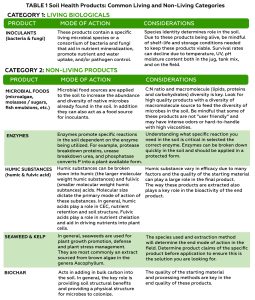
As the presence of soil health products grows in the marketplace with a predicted 10% increase over the next eight years, there have been increasingly more research studies evaluating the synergies or complementary effects of combining products. The main takeaway from this research reveals that mixing these different products together can give growers the benefit of multiple different modes of action that optimize results. These findings demonstrate the right combination of products achieves better or higher results than acting alone. However, this information should be taken with caution; just as adding modes of action with ag chemicals improves herbicide control rates, the wrong mix of chemicals can also create antagonism and cause a disaster. The same can be seen when tank mixing soil health products. This antagonism may not express itself as you may see in pesticide tank mix but could be just as devasting to your crop or act in a way to impede the mode of action of the products you mixed. Understanding a soil health product’s mode of action and how it interacts with other products are critical components to achieving tank mix or “blend” success.
Start with a Solution in Mind
Before you can get started blending soil health products, you must decide what you want to utilize in your operation, which can be a daunting step in this process due to the confusion in the marketplace. Thus, the first question to ask is what are you trying to achieve? You need to start with an end goal in mind. I would suggest you evaluate what is the yield limiting factor in your field. For example, is soil compaction leading to poor soil drainage and water holding capacity issues? Is your soil sample showing adequate nutrient levels, but nutrients aren’t seeming to move into the plants? Are nutrients not staying in your soils and leaching away? You may find that you have more than one issue. Once you can identify the main issue/s you are having in your field you can begin to select the correct mode of action/s to address the problems. Table 2 will walk you through a few common scenarios that are encountered in many fields that would benefit from soil health products and examples of products that would be a solution to those problems.
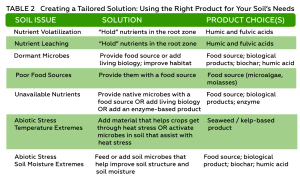
Building Your Soil Health Blend for Success
Now that we understand mode of action solution-based approaches, we can now begin to build a soil health blend. The next step are things to consider such as incompatibilities or antagonisms between products or in the field. Just like pesticide tank mixes physical, biological and chemical incompatibilities can occur with soil health products. Table 3, is a soil health blend checklist of questions you should ask while evaluating and building your soil health blend. The questions outlined in Table 3, not only encompass the mixing of the products but also bring to light other considerations such as shelf-life, viability and storage and handling requirements that may be different from other inputs we are more commonly used to.
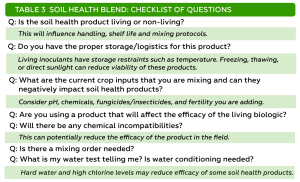
Soil health blends are the future of unlocking higher yields, more effective nutrient use, and improved crop quality. Understanding product mode of action and seeking sound advice from your retailer, CCA, or trusted advisor is key. To continue to improve our outputs we must be focused on our inputs. I challenge all of you to start thinking on how soil health blends can be utilized as a tool for success. If we think in terms of nutrient inputs, we would never consider only applying one standalone nutrient to a crop, and the same holds true for adding soil health inputs. Diversifying our inputs based on product mode of action, environmental needs and adopting the principal of blending soil health products will increase our chances of success in the field.
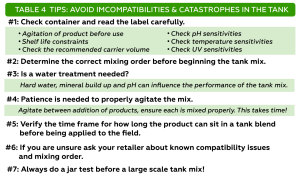
Resources
Tank mixing guide: https://ag.purdue.edu/department/extension/ppp/ppp-publications/ppp-122.pdf-
Research on combining biostumulants: https://www.ncbi.nlm.nih.gov/pmc/articles/PMC6243119/



